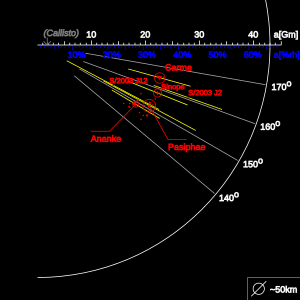Ananke (satelit)
 | |
| Penemuan | |
|---|---|
| Ditemukan oleh | S. B. Nicholson |
| Tanggal penemuan | 28 September 1951 |
| Ciri-ciri orbit | |
| Periapsis | 12.567.000 km |
| Apoapsis | 29.063.500 km |
Jari-jari orbit rata-rata | 21.280.000 km[1] |
| Eksentrisitas | 0,24[1] |
| 610,45 hari (1,680 a)[1] | |
Kecepatan orbit rata-rata | 2,367 km/s |
| Inklinasi | 148,89° (terhadap ekliptika) 149,9° (terhadap ekuator Jupiter)[1] |
| Satelit dari | Jupiter |
| Ciri-ciri fisik | |
Jari-jari rata-rata | 14 km[2] |
| ~2500 km2 | |
| Volume | ~11.500 km3 |
| Massa | 4,0×1016 kg |
Massa jenis rata-rata | 2,6 g/cm3 (perkiraan) |
| 0,010 m/s2 (0,001 g) | |
| ~0,017 km/s | |
| Albedo | 0,04 (perkiraan)[2] |
| Suhu | ~124 K |
Ananke (bahasa Yunani: Ανάγκη) adalah satelit retrograde ireguler Jupiter. Ananke ditemukan oleh Seth Barnes Nicholson di Observatorium Mount Wilson pada tahun 1951[3] dan dinamai berdasarkan tokoh mitologi Ananke, personifikasi dari "kebutuhan", dan ibu dari para Moirai ("takdir") bersama Zeus. Bentuk kata sifat dalam Bahasa Inggris dari Ananke adalah Anankean.
Ananke tidak memperoleh namanya yang sekarang[4] hingga tahun 1975.[5] Sebelumnya, satelit ini hanya dikenal sebagai Jupiter XII. Satelit ini juga kadang-kadang disebut sebagai "Adrastea"[6] antara tahun 1955 hingga 1975 (Adrastea sekarang menjadi nama dari satelit Jupiter yang lain).
Ananke juga menjadi nama untuk kelompok Ananke, yaitu kelompok satelit retrograde ireguler yang mengorbit Jupiter antara 19,3 hingga 22,7 Gm, dengan inklinasi sekitar 150°.[2]
Bersama Ananke, Jupiter untuk saat ini diketahui memiliki 79 satelit.
Orbit
[sunting | sunting sumber]Ananke mengorbit Jupiter dengan orbit retrograde yang memiliki eksentrisitas dan inklinasi yang tinggi. Delapan satelit ireguler yang mengorbit Jupiter yang telah ditemukan sejak tahun 2000 mengikuti pola orbit yang sama.[2] Elemen orbit dari satelit-satelit tersebut tercatat per bulan Januari 2000.[1] Elemen tersebut terus-menerus berubah oleh karena adanya gangguan matahari dan gangguan planeter dari Jupiter. Diagram di bawah, mengilustrasikan orbit Ananke dan kaitannya dengan satelit-satelit Jupiter ireguler berarah retrograde lainnya. Eksentrisitas dari orbit yang ditunjukkan di bawah diwakili oleh segmen kuning (yang membentang dari perisenter ke saposenter). Satelit reguler terluar Kalisto menjadi referensi untuk diagram lainnya.
Berdasarkan elemen orbit dan karakteristik fisik yang didapatkan sejauh ini, Ananke dianggap sebagai sisa-sisa pecahan asli yang terbesar[7] dari sisa-sisa yang membentuk kelompok Ananke.[8][9]
Ciri-ciri fisik
[sunting | sunting sumber]Dalam spektrum warna yang terlihat, Ananke tampak berwarna netral hingga merah muda (indeks warna B-V=0.90 V-R=0.38).[9]
Spektrum inframerah dari satelit ini mirip dengan spektrum dari asteroid tipe P, tetapi dengan petunjuk akan keberadaan air.[10]

Lihat juga
[sunting | sunting sumber]Referensi
[sunting | sunting sumber]- ^ a b c d e Jacobson, R. A. (2000). "The Orbits of Outer Jovian Satellites" (PDF). Astronomical Journal. 120 (5): 2679–2686. Bibcode:2000AJ....120.2679J. doi:10.1086/316817.
- ^ a b c d Sheppard, S. S., Jewitt, D. C., Porco, C.; Jupiter's Outer Satellites and Trojans Diarsipkan 2007-06-14 di Wayback Machine., in Jupiter: The Planet, Satellites and Magnetosphere, edited by Fran Bagenal, Timothy E. Dowling, William B. McKinnon, Cambridge Planetary Science, Vol. 1, Cambridge, UK: Cambridge University Press, ISBN 0-521-81808-7, 2004, pp. 263-280
- ^ Nicholson, S. B. (1951). "An unidentified object near Jupiter, probably a new satellite". Publications of the Astronomical Society of the Pacific. 63 (375): 297–299. Bibcode:1951PASP...63..297N. doi:10.1086/126402.
- ^ Nicholson, S.B. (April 1939). "S. B. Nicholson declines to name the satellites of Jupiter he has discovered". Publications of the Astronomical Society of the Pacific. 51 (300): 85–94. Bibcode:1939PASP...51...85N. doi:10.1086/125010.
- ^ Marsden, B. G. (7 October 1974). "Satellites of Jupiter". IAU Circular. 2846.
- ^ Payne-Gaposchkin, Cecilia; Katherine Haramundanis (1970). Introduction to Astronomy. Englewood Cliffs, N.J.: Prentice-Hall. ISBN 0-13-478107-4.
- ^ Sheppard, S.S.; Jewitt, D.C. (2003). "An abundant population of small irregular satellites around Jupiter" (PDF). Nature. 423 (6937): 261–263. Bibcode:2003Natur.423..261S. doi:10.1038/nature01584. PMID 12748634. Diarsipkan dari versi asli (PDF) tanggal August 13, 2006.
- ^ Nesvorný, D.; Beaugé, C.; Dones, L. (2004). "Collisional Origin of Families of Irregular Satellites". The Astronomical Journal. 127 (3): 1768–1783. Bibcode:2004AJ....127.1768N. doi:10.1086/382099.
- ^ a b Grav, Tommy; Holman, M. J.; Gladman, B. J.; Aksnes, K. (2003). "Photometric survey of the irregular satellites". Icarus. 166 (1): 33–45. arXiv:astro-ph/0301016
 . Bibcode:2003Icar..166...33G. doi:10.1016/j.icarus.2003.07.005.
. Bibcode:2003Icar..166...33G. doi:10.1016/j.icarus.2003.07.005.
- ^ Grav, Tommy; Holman, Matthew J. (2004). "Near-Infrared Photometry of the Irregular Satellites of Jupiter and Saturn". The Astrophysical Journal. 605 (2): L141–L144. arXiv:astro-ph/0312571
 . Bibcode:2004ApJ...605L.141G. doi:10.1086/420881.
. Bibcode:2004ApJ...605L.141G. doi:10.1086/420881.
Sumber
[sunting | sunting sumber]- Ephemeris IAU-MPC NSES
Pranala luar
[sunting | sunting sumber]- Ananke Profile by NASA's Solar System Exploration
- David Jewitt pages
- Scott Sheppard pages
- http://solarsystem.nasa.gov/planets/profile.cfm?Object=Jupiter&Display=Moons Diarsipkan 2013-07-06 di Wayback Machine.
- http://alienworlds.southwales.ac.uk/jovianMoons.html Diarsipkan 2013-10-05 di Wayback Machine.
- http://www.orbitsimulator.com/gravity/articles/joviansystem.html
Diurutkan dari jarak yang terdekat dengan Jupiter. Sebutan sementara ditulis miring. | |
| Satelit dalam (4) | |
| Satelit Galileo (4) | |
| Kelompok Themisto (1) | |
| Kelompok Himalia (9) | |
| Kelompok Carpo (2) | |
| Kelompok Valetudo (1) | |
| Kelompok Ananke (25) | |
| Kelompok Carme (28) | |
| Kelompok Pasiphae (18) | |
| |
Text is available under the CC BY-SA 4.0 license; additional terms may apply.
Images, videos and audio are available under their respective licenses.
